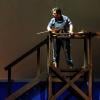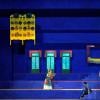
As its contribution to the California Festival, Los Angeles Opera joined the neighboring Los Angeles Philharmonic in giving the lion’s share of attention to Latin American music and performers. LA Opera has been there before, championing the works of Daniel Catán (Florencia en el Amazonas and Il Postino) at its inception before they became part of the repertoire, and now the company might have another candidate for widespread exposure in Gabriela Lena Frank’s haunting new opera El último sueño de Frida y Diego (The last dream of Frida and Diego).
LA Opera is the third company to take the work on — San Diego Opera unveiled it first, in October 2022, and San Francisco Opera staged it this past June. In doing so, the companies have expanded the presence of Latin American performers and crew. Three of the four lead roles at LAO are inhabited by singers from Argentina, Puerto Rico, and Mexico. The conductor is from Colombia. The director, choreographer, and scenic, lighting, and costume designers are all from Mexico City.
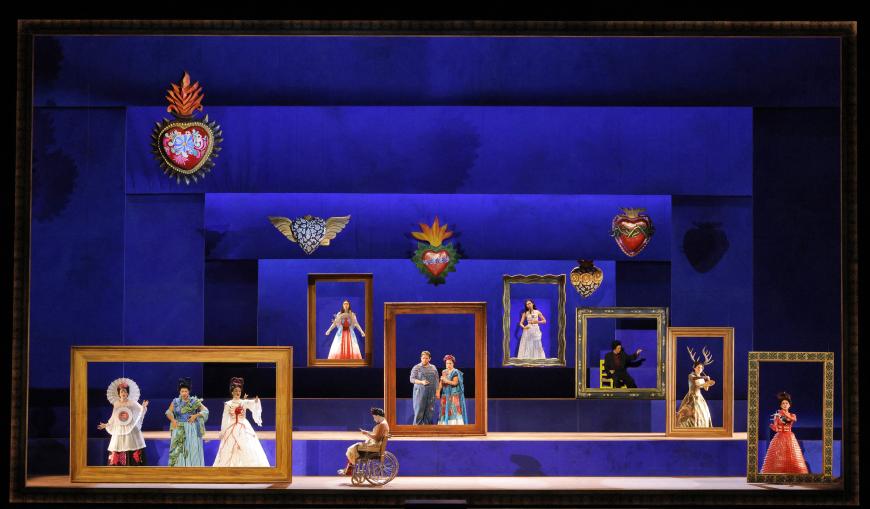
Frida y Diego is an opera in musical language, all right, yet it often seems more like a mural come to life — which makes sense because the story involves one of the most famous muralists of the 20th century, Diego Rivera (1886–1957). He was a controversial character — a communist, a friend of Leon Trotsky, an atheist, temperamental. His third wife (and fourth, since they were remarried after their divorce), Frida Kahlo (1907–1954), was also a painter, also a member of the Mexican Communist Party (that’s how they met), a woman wracked with physical and emotional pain for most of her life.
Ironically, while Rivera was far better known during his time and still commands attention, Kahlo’s reputation, amplified by her personal struggles, has soared beyond his since the 1980s, with subsequent generations linking her with feminism and Mexican identity. “Fridamania,” they call it.
Not much of this history matters in the opera, though. There is no politics and no Fridamania in Nilo Cruz’s libretto. The story takes place on Nov. 2, 1957, on Día de los Muertos — about three weeks before Rivera’s actual death — but we are not particularly aware of those dates.
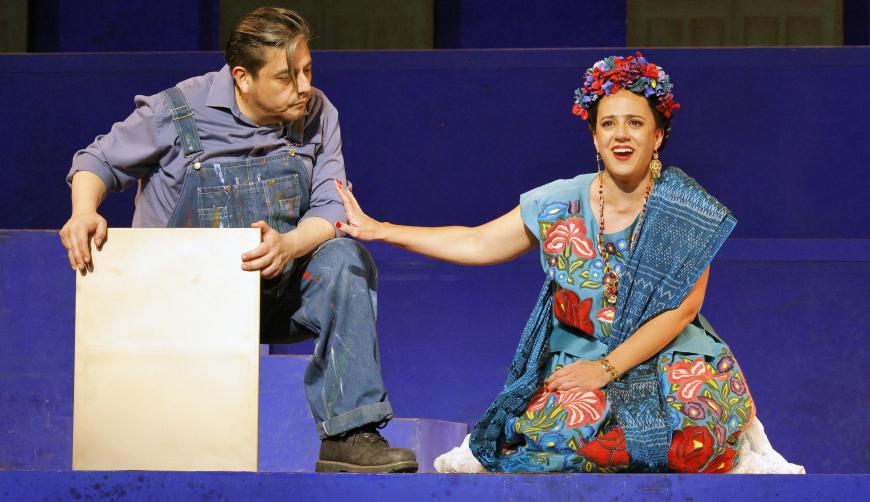
Rather, the plot is a fantasy in which Frida, who passed away three years before the opera’s timeframe, wonders whether she should come back to earth and reunite with Diego, who misses her terribly despite their battles during life. Eventually, she decides to return to earth and Diego in a dream world of art, but only for 24 hours (and no touching allowed). When it is time to go back to Mictlan, the Aztec underworld, the couple realizes that they can’t live in this dream world forever, and Diego begs the powers that be to let him join her in the underworld, which they do.
There is an animating force in the form of the character Catrina, who is sort of a skeleton ringmaster of the dead, and there is a slightly distracting subplot featuring Leonardo, a good-hearted fellow who wants to come back to earth in order to impersonate Greta Garbo for a fan who always wanted to meet the actress.
Yet the overall story almost seems beside the point, as the audience is invited to bathe in the sumptuously colorful images that director Lorena Maza, scenic designer Jorge Ballina, costume designer Eloise Kazan, and lighting designer Victor Zapatero have dreamed up.
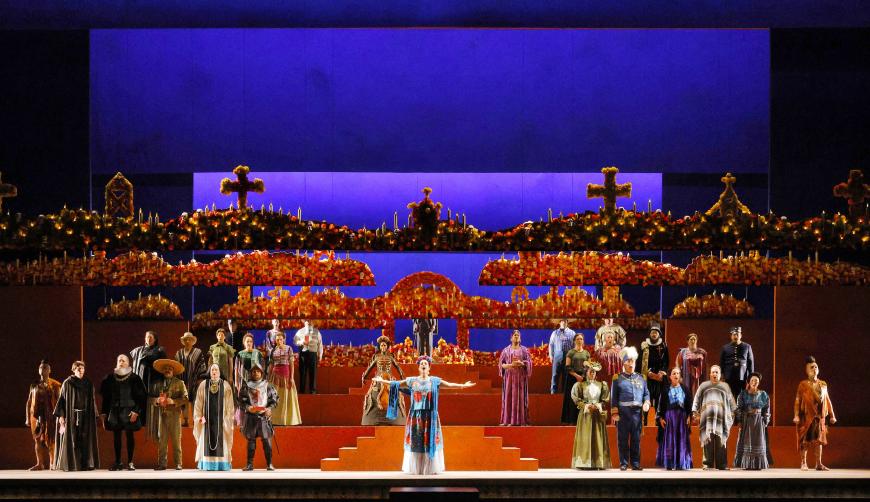
The first act is paced like a ritual before a stunningly detailed Día de los Muertos set full of tiny lights, flowers, skulls, and black-and-white photos of the departed. The primary colors are orange and deep blue, patterned after Kahlo’s actual home, La Casa Azul, now a museum in Mexico City.
The characters in one of the paintings come to life in Act 2, and one is immediately and pleasantly reminded of a similar moment in Stephen Sondheim’s Sunday in the Park With George. Indeed, the entire proscenium is set in a picture frame, and occasionally there are picture frames within the overall frame, reinforcing the impression that the opera is mostly a beguiling series of live-action paintings and murals with a soundtrack.
Frank’s score moves slowly along in Act 1, with sustained singing lines sometimes recalling Benjamin Britten at his moodiest and consonant harmonies representing Diego that turn somewhat dissonant when Frida appears on the scene. When Diego is seen alone on his painter’s scaffold against a blank wall canvas at the beginning of Act 2, the music turns agitated and troubled, as he can’t get started on any work. It’s a completely different mood in sight and sound from much of the first act. Ultimately, the music in the last scene in the underworld lingers longest in the mind; the orchestra mourns, with rising clusters in the winds and glockenspiel decorating the texture, and a bell gently clangs soulfully at the close.
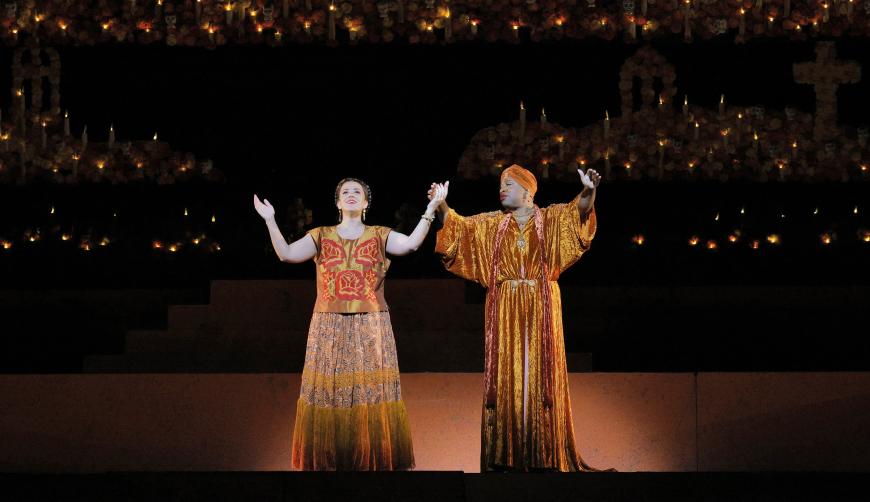
The original Diego in San Diego and San Francisco, Alfredo Daza, was back in the role, bringing a somewhat wavery baritone that suited the aging painter. Mezzo-soprano Daniela Mack, who was the Frida in S.F., reprised the role in L.A., and the original Leonardo in San Diego, Key’mon W. Murrah, returned as the would-be Garbo impersonator, singing quite sweetly in liquid countertenor tones. The part for Catrina veers considerably in range from mezzo to soprano territory, and the versatile soprano Ana María Martínez, in her tenth leading role with LA Opera (reportedly a company record), handled it easily with some humorous touches. LAO Resident Conductor Lina González-Granados lovingly led the orchestra in the pit.
The audience reaction in the Dorothy Chandler Pavilion on Saturday night, Nov. 18 was interesting. Compared with, say, the instant standing ovations that Omar, another new opera based on real historical characters, received, the initial response to Frida y Diego was moderate rapture, with very few folks standing in the orchestra level. But the applause built slowly until finally almost everyone stood — as if they were gradually pulled out of the dreamlike state that this work of art had created. This piece will sneak up on you. LA Opera’s production runs through Dec. 9.



